
Vol. 1 No. 1 Spring 1999
Raymond L. Brock. . . Chairperson,
Department of Physics and Astronomy
Wolfgang W. Bauer . . Associate Chairperson for Undergraduate
Instruction
Phillip M. Duxbury . . . . . . Associate Chairperson for Graduate
Instruction
Bernard G. Pope. . . . . . . . . . . . . . . . Associate Chairperson
for Operations
Eugene J. Kales. . . . . . . . . . . . . . . . . . . . . . .
Newsletter Production Editor
A Letter from the Chair
It is my pleasure to invite you to the first in what we intend to
be a regular series of newsletters produced for alumni and friends of
the Department of Physics and Astronomy. My name is Chip Brock and
I've been chairperson of the Department for a bit more than five
years. As you'll learn over the next year or so, we've embarked on a
number of exciting projects which will continue to increase the
quality and visibility of our research efforts and significantly
enhance the educational experiences which we offer to our students.
We have not done an acceptable job of keeping our extended family up
to date and I hope that you'll appreciate our new efforts.
For those of you who have not been in touch with us for a while,
we've grown into a large physics and astronomy department with 59
full time faculty, still concentrated into four "interest groups." We
are an active department: 89% of the faculty are supported by regular
federal research grants which now amount to approximately $13M per
year, including $9M from the NSF for the National Superconducting
Cyclotron Laboratory. Support for our faculty comes from NSF, DOE,
NIH, and various agencies of the DOD. 97% of the faculty published
results of their research in peer-reviewed journals last year.
All groups are involved in major initiatives, and we'll touch on
them in coming issues. Briefly: the nuclear physics group has begun a
major upgrade of their unique facility in order to evolve into the
premier source of high-intensity radioactive beams in the world. The
competition for this upgrade was fierce and was won as a major
construction project of the NSF due to the reputation and skill of
the nuclear group as well as the imagination of the central MSU
administration. The high energy physics group is deeply involved in
both the leadership and the details of the upgrades of the two major
detectors at Fermilab which are in pursuit of the top quark and the
Higgs Boson. All 7 of the high energy physics faculty are similarly
involved in the design and construction of the Atlas detector at the
Large Hadron Collider at CERN. The condensed matter physics group has
recently been renewed for another five year period in their
successful $12M Materials Research, Science and Engineering Center
grant from the NSF. We're also embarking on major programs at the
Advanced Photon Source at Argonne National Laboratory and have begun
significant research efforts in what has come to be known as
"quantitative biology". Finally, the department has, after many years
of trying, found a permanent astronomical home for optical and
infrared astronomy. We have joined a consortium to construct a 4m
telescope in Chile which should be completed by 2002. All of these
efforts demonstrate the significant degree to which we're continuing
to excel in our research during time of difficult overall funding.
We've hired a number of excellent young faculty in all areas and they
have taken on their responsibilities with enthusiasm. In this and
subsequent issues, we'll endeavor to describe our research efforts in
detail through short articles by the faculty involved.
One of the big stories for us is that after a half century we have
begun construction of a new building to be located on south campus.
This will be a fantastic structure for research and teaching. Wayne
Repko has a short article in this issue with more detail. Please note
drawings on the back of this letter.
After an all-time high in 1991 of 170 graduate students, we are
currently supporting 125 as TA's and RA's. It's no secret that we,
like most physics departments, are actively searching for good
students as our research programs are easily able to support more.
We've recently reviewed the entire graduate program and have
significantly altered our examination procedures and have coordinated
our basic graduate course content. We have similarly reviewed our
undergraduate major program and are considering the introduction of a
series of applied degree options in concert with other departments on
campus. I anticipate an external review of this particular effort and
may be contacting some of you with a request for your help and
advice.
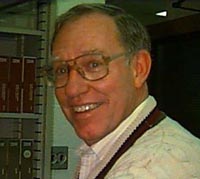 The
last couple of years have delivered some sadness to us. In February
of 1997 we were shocked when Professor Carl Foiles collapsed while
playing tennis and subsequently did not recover from a massive heart
attack. Then, just last month, we were saddened when Jerry Cowen's
heroic yearlong battle with cancer took his life in a swift decline.
Both faculty will be remembered with fondness for their commitment to
their department and their superior work as undergraduate teachers.
[As we were completing the preparation of this Newsletter we
learned the sad news that another longtime faculty member, Harvey
Edwards, passed away on April 14. Professor Edwards came to MSU in
the middle 50's after completing his PhD at the University of
Michigan.]
The
last couple of years have delivered some sadness to us. In February
of 1997 we were shocked when Professor Carl Foiles collapsed while
playing tennis and subsequently did not recover from a massive heart
attack. Then, just last month, we were saddened when Jerry Cowen's
heroic yearlong battle with cancer took his life in a swift decline.
Both faculty will be remembered with fondness for their commitment to
their department and their superior work as undergraduate teachers.
[As we were completing the preparation of this Newsletter we
learned the sad news that another longtime faculty member, Harvey
Edwards, passed away on April 14. Professor Edwards came to MSU in
the middle 50's after completing his PhD at the University of
Michigan.]
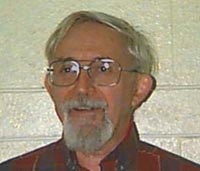 We
hope to hear from you. Jules Kovacs is attempting to find as many of
you and your classmates as he can. If you have any knowledge of the
whereabouts of your friends, we'd appreciate hearing from you. We
plan to construct a chat area in our web site specifically for you to
encourage your assistance as we try to establish the whereabouts of
more of our alumni. Visit our cyber home at http://www.pa.msu.edu
in order to catch up and stay informed as we pursue our future
programs. You'll also hopefully find it as a means of reestablishing
contact with your former colleagues. We'll be in touch with you again
in the fall as we introduce our new classes to you. Please feel free
to drop any of us a note or email message!
We
hope to hear from you. Jules Kovacs is attempting to find as many of
you and your classmates as he can. If you have any knowledge of the
whereabouts of your friends, we'd appreciate hearing from you. We
plan to construct a chat area in our web site specifically for you to
encourage your assistance as we try to establish the whereabouts of
more of our alumni. Visit our cyber home at http://www.pa.msu.edu
in order to catch up and stay informed as we pursue our future
programs. You'll also hopefully find it as a means of reestablishing
contact with your former colleagues. We'll be in touch with you again
in the fall as we introduce our new classes to you. Please feel free
to drop any of us a note or email message!
Raymond Brock
brock@chip.pa.msu.edu
|
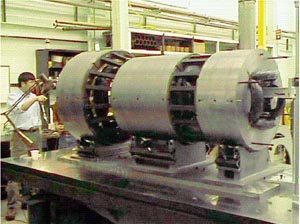
|
|
The three quadrupoles of one triplet being aligned on a
surface plate.
|
NSCL Cyclotron Upgrade: The Coupled Cyclotron Project
Orilla McHarris
The NSCL is now in the process of an upgrade which will
dramatically increase its capability by coupling the two existing
superconducting cyclotrons (K500 and K1200) and by replacing the
existing fragment separator (A1200) with one of increased capacity
(A1900). The coupling of the cyclotrons will provide dramatic
increases in the primary beam intensity, as well as increasing the
energy of heavy ions, permitting a wide variety of experimental
programs to be undertaken which are presently not feasible. The
upgraded facility will provide a unique resource to the worldwide
nuclear science community by filling a need for both stable and
radioactive ion beams in an interesting and nearly unique energy
domain. The high energies (90 MeV/nucleon for uranium) are an
excellent match to the needs for studies of heated, compressed
nuclear matter. The complementary aspects of the high intensity and
low emittance for lighter ions are an excellent match to the needs of
the growing radioactive ion beam field, as they provide very intense,
good-quality secondary beams produced in fragmentation at a
production target. The K500 cyclotron was completed in 1982 as the
world's first superconducting cyclotron, and as such was
prototypical. The K500 had known reliability problems, undesirable
magnetic field harmonics, and a relatively poor beam chamber vacuum.
When the K1200 was later constructed, the lessons learned were
applied, and the K1200 has significantly better attributes and a
notable reliability of >90%. The K500 was first completely
disassembled to make significant improvements to the cyclotron vacuum
system. It was thereafter reassembled, and, guided by magnetic field
maps, yoke steel modifications were made which reduced the
undesirable field harmonics. The K500 rf system was replaced with one
following the K1200 system design.
A magnetic system will transport beam from the K500 to the K1200.
Installation of a mechanism to position the thin carbon stripping
foils and improvement of the robustness of the extraction septa are
the primary K1200 upgrade activities. (The capability to operate the
K1200 in stand-alone mode will be retained.) The foil mechanism
inside the cyclotron has been designed and construction initiated.
The design of a loading system, which will allow foil replacement
without interrupting the cyclotron vacuum, is in progress. A program
to improve the K1200 extraction system was begun about two years ago
and is planned to continue until the coupled cyclotron commissioning
in the year 2001.
A major element of the upgrade is a new fragment separator with an
increased rigidity and greater collection efficiency. The A1900 will
use 24 quadrupoles configured in eight triplet packages, and four
45° dipoles in a reverse bend geometry so that incoming and
outgoing beams are coaxial.
The A1900 magnets are energized by superconducting coils.
Beginning in mid 1999, the K1200-supported experimental nuclear
physics program will be stopped for a period of approximately 18
months to reconfigure the facility and install new equipment. A six
months commissioning period is planned in 2001 with project
completion scheduled during that year. The coupled cyclotron project
is jointly funded by Michigan State University and the National
Science Foundation.
The New Building
Wayne Repko
The new Biomedical and Physical Sciences Research Center will be
located just west of the Biochemistry Building on a site extending
north from Wilson Road toward the Chemistry Building. It will be
connected above ground to both buildings by enclosed overhead
walkways and at the basement level. Construction costs are estimated
at $92 million. The Physics-Astronomy research space will be located
in the basement, which will contain 21 condensed matter physics
research laboratories, including a large clean room facility, and on
the first floor, which will house high energy physics and
astrophysics labs and the mechanical and electronics shops. The
teaching facilities will include three lecture rooms with capacities
of about 300, 180 and 65 students. Entrances to these rooms will be
located in the atrium area. In addition to the lecture rooms, there
will be eight undergraduate teaching labs, two regular classrooms and
a large space for undergraduate help sessions. The Physics-Astronomy
library, enlarged to hold Chemistry and Biomedical collections, will
be located on the atrium opposite the large lecture rooms. All
current P-A departmental office space will be located in the new
building; NSCL faculty will remain at the Cyclotron Lab.
The Department office will be located on the fourth floor of the
office tower, with faculty offices on the third and fourth floors.
The Undergraduate office will be on the first floor near the
building's main entrance. There will also be an Astronomy observing
and control room in the atrium, where real time observing at various
remote telescopes can be analyzed.
The anticipated completion date for the project is January 2002. A
virtual reality video has been prepared and is located off the
department home page. A real-time camera is recording construction
and can be viewed at http://theo08.nscl.msu.edu/ConCam/
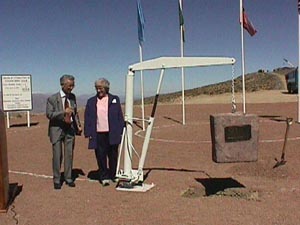
|
|
May 1998 Stone laying
|
Astronomy: SOAR
Horace Smith
The SOAR telescope is closer to reality after groundbreaking and
the start of site preparation in Chile. The innovative new telescope
is being built upon Cerro Pachon, a mountaintop not far from the
existing Cerro Tololo Interamerican Observatory. The SOAR telescope,
which will have an objective mirror four meters in diameter, is a
collaboration among the National Optical Astronomy Observatories, the
University of North Carolina, the country of Brazil, and Michigan
State University. Gene Capriotti, Susan Simkin, and Vice-President
for Research and Graduate Studies Robert Huggett represented MSU at
the groundbreaking.
Cerro Pachon is located near the southern edge of Chile's Atacama
desert. Skies there will not only be frequently clear, but the
astronomical "seeing" (the sharpness of the star images) is also
expected to be very good. The SOAR telescope is being designed to
exacting mechanical and optical tolerances so as to be able to take
full advantage of this excellent seeing and will be nearly
diffraction-limited in the near infrared frequencies.
The Chilean location has other advantages as well. Whereas the
astronomically active center of the Milky Way Galaxy barely rises far
above the southern horizon as seen from Michigan, for the SOAR
telescope it will pass spectacularly overhead. Moreover, the Large
and Small Magellanic Clouds, satellite galaxies of the Milky Way, can
be well observed from Chile, but never rise above the horizon in
Michigan.
The SOAR telescope will provide MSU astronomers with access to a
world class astronomical instrument. Data links from Chile to
Michigan will make the telescope accessible to Michigan students on
and off the MSU campus, who will not need to travel to Chile to make
use of the telescope. The Physics and Astronomy Department is now
beating the bushes for donations to help raise MSU's six million
dollar share of the cost of building the SOAR telescope. Roughly
$2.1M has been raised to date.
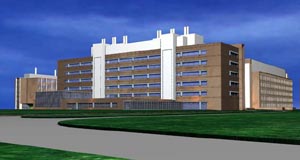
On February 10, 1999, ground was broken for
a new science building which will house the Departments of Physics
and Astronomy, Physiology, and Microbiology. Officially known as the
Biomedical and Physical Sciences Research Center, the building plans
were developed over the last three years with input from the
faculties of all three departments. The final design consists of a
six-story research tower, a four-story office tower, and a one story
shop and lab annex connected on the ground floor by an
atrium.
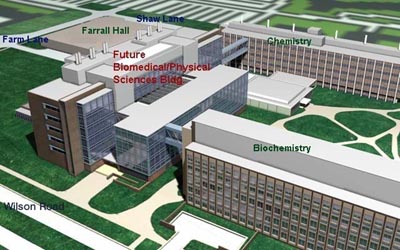
http://www.pa.msu.edu/alumni.htm
email: newsletter@pa.msu.edu